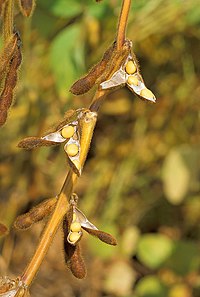
Photo from wikipedia
Partially-hydrogenated fat/trans fatty acid intake has been associated with adverse effects on cardiometabolic risk factors. Comparatively unexplored is the effect of unmodified oil relative to partially-hydrogenated fat on the plasma… Click to show full abstract
Partially-hydrogenated fat/trans fatty acid intake has been associated with adverse effects on cardiometabolic risk factors. Comparatively unexplored is the effect of unmodified oil relative to partially-hydrogenated fat on the plasma metabolite profile and lipid-related pathways. To address this gap, we conducted secondary analyses using a subset of samples randomly selected from a controlled dietary intervention trial involving moderately hypercholesterolemic individuals. Participants (N = 10, 63 ± 8 y, BMI, 26.2 ± 4.2 kg/m2, LDL-C, 3.9 ± 0.5 mmol/L) were provided with diets enriched in soybean oil (SO) and partially-hydrogenated soybean oil (PHSO). Plasma metabolite concentrations were determined using an untargeted approach and pathway analysis using LIPIDMAPS. Data were assessed using a volcano plot, receiver operating characteristics curve, partial least square-discrimination analysis and Pearson correlations. Among the known metabolites higher in plasma after the PHSO diet than the SO diet, the majority were phospholipids (53%) and di- and triglycerides (DG/TG, 34%). Pathway analysis indicated upregulation of phosphatidylcholine synthesis from DG and phosphatidylethanolamine. We identified seven metabolites (TG_56:9, TG_54:8, TG_54:7, TG_54:6, TG_48:5, DG_36:5 and benproperine) as potential biomarkers for PHSO intake. These data indicate that TG-related metabolites were the most affected lipid species, and glycerophospholipid biosynthesis was the most active pathway in response to PHSO compared to SO intake.
Journal Title: Metabolites
Year Published: 2023
Link to full text (if available)
Share on Social Media: Sign Up to like & get
recommendations!